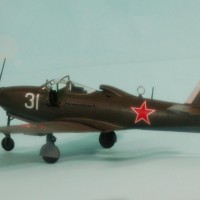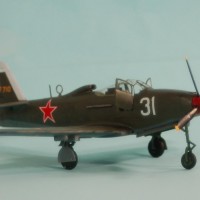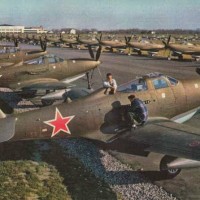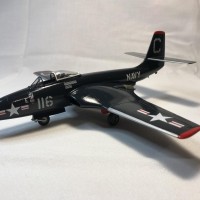Review: Dora Wings1/48 P-63C King Cobra
When it was decided that the P-39 would lose the turbocharger it was originally equipped with, high-altitude performance suffered,and Bell Aircraft proposed an experimental series to solve the problem. The result was the XP-39E, which featured two primary changes from the earlier P-39D, from which it was developed. First was a redesigned wing. The root airfoil, a NACA 0015 on the P-39D, was changed to a NACA 0018, to gain internal volume. Second was a switch to the Continental I-1430 engine, which featured an improved supercharger.
In April, 1941, three prototypes were ordered. Development problems with the I-1430 resulted in its replacment by an Allison V-1710-47. The XP-39E was faster than standard Airacobra,with a maximum speed of 386 mph. Unfortunately, the XP-39E was considered inferior to the stock P-39 Airacobra in all other respects and was not ordered into production.
Although the XP-39E proved disappointing, the USAAF was interested in Bell's further idea, a larger aircraft based on the same basic layout and was so impressed with Bell's proposal that an order was placed on 27 June 1941 for two prototypes of an enlarged P-39 powered by the same V-1710-47, designated the XP-63. The XP-63 was larger in all dimensions than the Airacobra. The wing was redesigned, with new NACA laminar flow airfoils. The engine was given a second-stage supercharger. A four-blade propeller was also standardized. A persistent complaint against the Airacobra was that its nose armament was not easily accessible for ground maintenance; the XP-63 airframe was fitted with larger cowling panels. Prior to prototype first flight, the airplane was ordered into production in September 1942 as the P-63A (Bell Model 33). Armament was to be the same as the current P-39Q, a single 37 mm M4 cannon firing through the propeller hub, two synchronized 50-caliber machine guns in the cowl, and two 50-caliber machine guns in underwing gondolas.
The prototype flew for the first time on December 7, 1942. On January 28, 1943, the landing gear failed to extend and it was destroyed in an emergency landing. The second prototype was destroyed on February 5, 1943, due to engine failure.
Production P-63A deliveries began in October 1943. The USAAF concluded the Kingcobra was inferior to the Mustang, and decided to stop production. However, the Soviet Union, the largest user of the Airacobra, requested that the airplane be produced for them. In February 1944, the Soviets sent a highly experienced test pilot, Andrey G. Kochetkov, and aviation engineer Fyodor P. Suprun, to the Bell factories to work on development of the P-63A. Initially ignored by Bell's engineers, Kochetkov's expert testing of the machine's spin characteristics - which led to airframe buckling - led to a significant Soviet role in further development. After flat spin recovery proved impossible, Kochetkov's recommendation that pilots should bail out upon entering such a spin, resulted his commendation from the Irving Parachute Company. The maximum aft CG was moved forward to facilitate recovery from spins.
P-63A-8, SN 269261, was extensively tested at TsAGI in the world's largest wind tunnel. Soviet input was significant and Bell was quick to implement their suggestions. The vast majority of changes in the P-63A sub-variants were a direct result of Soviet input, including increased pilot armor and fuselage hard point on the A-5, underwing hard points and extra fuel tanks on the A-6. Most significantly, Soviet input resulted in moving the main cannon forward, changing the center of gravity and increasing ammunition from 30 to 58 rounds for the P-63A-9.
In Soviet Service:
The first version of the P-63 supplied in quantity to the Soviet Union was the P-63A-7. Air Transport Command ferry pilots picked up the planes at the Bell factory at Niagara Falls, New York, and flew them to Great Falls, Montana and then onward via the Northwest Staging Route through Canada to Alaska, Soviet ferry pilots took delivery of the aircraft at Nome and flew them to the Soviet Union over the Bering Strait via the Alaska-Siberia route. A total of 2,397 P-63s were delivered to USSR, of the overall 3,303 production P-63s.
By a 1943 agreement, P-63s were supposed to be held in the Soviet Far East for an eventual attack on Japan. However, there are many unconfirmed reports from both Soviet and German sources that P-63s did see service against the Luftwaffe. Most notably, one of Pokryshkin's pilots wrote in his memoirs that the entire 4th Guards Fighter Aviation Regiment (4 GvIAP) was secretly converted to P-63s in 1944, while officially still flying P-39s. He stated they were in action at Königsberg, in Poland, and in the final assault on Berlin. German sources reported P-63s shot down by both fighters and flak. Hans Rudel stated in his memoirs, "We often encounter American types of aircraft, especially Airacobras, Kingcobras and Bostons." This was in the Courland front towards the end of the war.
In the Far East, P-63 and P-39 aircraft were used in the Soviet invasion of Manchukuo and northern Korea. The Kingcobras flew escort, close air support and ground attack missions. The first air victory happened on 15 August 1945, when Lieutenant I. F. Miroshnichenko of the 17th IAP/190 IAD, shot down a Nakajima Ki-43 Hayabusa IJAAS fighter off the coast of North Korea.
The Soviet Union retained the P-63s in service in such numbers after the war for the P-63 to be given the NATO reporting name of Fred. On October 8, 1950, two USAF F-80Cs from the 49th Fighter Group attacked Sukhaya Rechka airfield 19 miles south-west of Vladivostok and 62 miles from the Soviet-Korean border, making two strafing runs before returning to their home base; the pilots claimed it was a navigational error. The airfield was used by the Air Forces of the Pacific Fleet (VVS TOF), but was occupied by the 821st Fighter Aviation Regiment (821 IAP) of the 190th Fighter Aviation Division (190 IAD), operating P-63s. Twelve P-63s were damaged and one burned out.
THE KIT
Kits of the P-63 have been few and far between. I managed to build a Hi-Tech resin kit that was one of the worst resin limited run kits I ever attempted. I eventually gave up on the MPM limited-run injection-molded kit; nothing fit and the fuselage halves were different lengths.
This kit by Dora Wings solves the previous problems. It is limited-run, but with much better design and production quality. The manufacturer has started with lesser-known versions, including the TP-63E of which two ever existed, followed by the P-63E of which only 12 were ever built. Fortunately, it's not difficult to turn this into a P-63C, which accounted for a good third of those sent to the USSR.
Surface detail is excellent, parts fit is good. The kit provides markings for two USAAF P-63Es and two P-63Es operated postwar by the Honduran Air Force.
CONSTRUCTION
Just remember, this is a limited-run kit. Test-fit thrice before gluing once. This is particularly important, given that some parts need modification before assembly. If you do this and assemble with care, you will have an excellent model.
By carefully test-fitting all parts and trimming where necessary, I was able to assemble the entire airframe without any filler anywhere. This was very impressive, and the necessary modifications to kit parts was not difficult. I found it a good idea to cut off the locator pins because the alignment of pins and holes on corresponding parts was just off enough to create real difficulty in further assembly. Anyone who has built a limited-run kit without locator pins will have no problem with this.
After assembling the wing (and opening up the landing light in the upper left wing for an earlier P-63), I moved on to the fuselage. The cockpit was painted Tamiya “Deep Green,” which looks like the P-39s restored at Fighter Rebuilders and Yanks Air Museum, which are commended for their accuracy. I used the kit instrument panel decal, and Eduard photo-etch USAAF seat belts.
The wing and fuselage sub-assemblies came together well. Many photos show the flaps dropped, but the kit flaps wanted to be assembled up for fit.
The only real difficulty I found was that the cockpit clear parts are molded so they are a bit narrower than the corresponding place they should fit to the fuselage. I scored the rear glass down the centerline (which has a metal frame) and bent it out to fit. I trimmed the fuselage to fit the glass for the forward section, which also had to be trimmed at the rear to fit properly. I decided to pose both doors open rather than worry about fitting one closed.
I used the air intake parts not called for in the instructions, which are right for the P-63C. I attached these to their respective fuselage halves before assembling further, so I could get the fit right working from inside and outside.
COLORS & MARKINGS
I painted the model Olive Drab and Neutral Grey, with some post-shading. I didn't find any photos of P-63Cs on operations, but found some paintings and profiles, which I decided to follow. Using decals out of the dungeon, I found red stars and “Bell font” serial numbers I could use to do my impression of a P-63C in the Far East campaign.
The kit wheels are the one really poor part. I used wheels from an Airfix Mustang for the main gear and then sanded down the parts for the kit nosewheel to make something that fit. I also ended up adding 1/16"to the nose gear leg to get proper sit. I posed both cockpit doors open.
CONCLUSIONS
If you want a P-63 in your collection, this kit from Dora Wings is what you want. You can do a P-63E (though you really need “paddle blade” props for the later airplane - the prop in the kit is right for a P-63A or P-63C). It assembles easily for a limited-run kit and if you take your time it comes together really nicely. I am told a P-63A without the ventral fin is also on the production list. Modelers with experience with limited-run kits will enjoy this model.
























Nice job, TC - and the addition of the photos are an added bonus.
The P-63A is the one Colonel Frank Borman (commander of Apollo-8) restored to "right off the assembly line" condition.
Thanks - (I knew someone had one they flew, but couldn't remember who).
As usual, great history followed by a very nice build
I always liked the look of the P 39 Airacobra. Your model of the P 63 is superb in every aspect. Well done! Thanks again for the superb history lesson, always the highlight for me!
good looking kit...great looking build
Love the model, love the presentation!
I'm with Morne; great build and a very interesting history lesson about one of the lesser known fighters of WWII.
I like the photos of the real plane you included, too.
Nicely done Tom, I've always wondered why nobody has done a decent kit of this A/C. Likely because of it's lack of history with the US forces. I've seen Borman's P-63A on the flight line as well as in the air, and it's gorgeous to say the least.
"I’ve always wondered why nobody has done a decent kit of this A/C"
Earlier in the war the Americans didn't want to having anything to do with that English plane...the P-51/P-36 Mustang. It took away engines and tied up production for more serious American aircraft like the P-40,P-39,P-47 and P-38. Then they married it to the Merlin.
Some of that prejudice applies to the King Cobra...that Russian plane. The Mustang was Strategic and the King Cobra was tactical. The Russians integrated there a/c with the army...the Americans wanted and an air force free of ground constraints. So the Russians got the Cobra and fought with it. I'am sure there is a "history" of Russian achievements but, it ain't American and therefore the subject matter is passe to some folks.
Nice built up kit and I like the photos of the real a/c . Its a good departure from the normal TC article. I also, like it when folks add a few in progress photos of how the magician does his magic.
You presented a really fine article with pictures of a great build with nice outcomes. Very informative and enjoyable to read. Love the pictures to support the build. Your photographic skills are top notch also. I need to work on my picture taking b/c I always get negative comments regarding my lack of ability...LOL!
Just get a nice little Nikon Coolpix pocket camera - they're cheap on eBay if you get an earlier one, which is all you need for model photography. It has an autofocus, so you'll get a sharp picture, which is your main problem. And then get all the light you think you need and add 100% more. Get "daylight" bulbs. I use two sheets of light blue poster paper for backdrop.
Thanks for building this one, Tom. I was curious about this kit and will be picking one up.
A good-looking 'cobra!